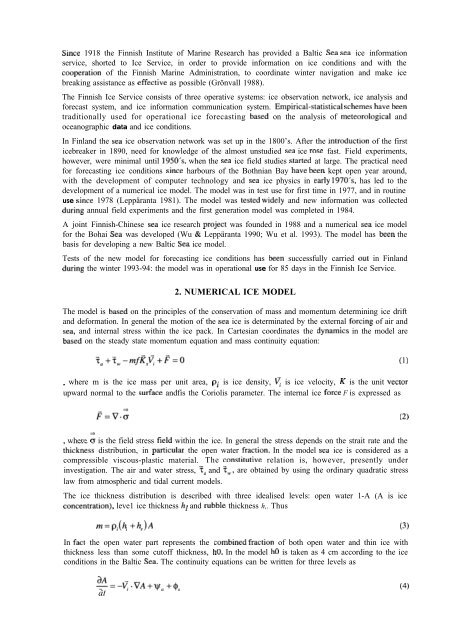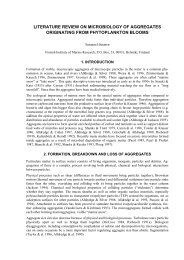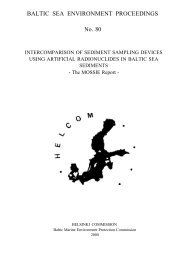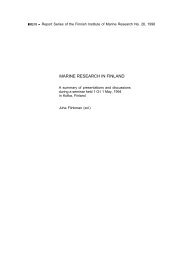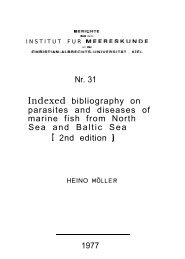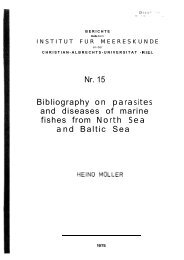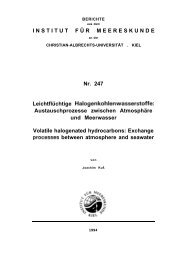the numerical sea ice forecast in finland in the winter 1993-94 ...
the numerical sea ice forecast in finland in the winter 1993-94 ...
the numerical sea ice forecast in finland in the winter 1993-94 ...
- No tags were found...
Create successful ePaper yourself
Turn your PDF publications into a flip-book with our unique Google optimized e-Paper software.
S<strong>in</strong>te 1918 <strong>the</strong> F<strong>in</strong>nish Institute of Mar<strong>in</strong>e Re<strong>sea</strong>rch has provided a Baltic Sea <strong>sea</strong> <strong>ice</strong> <strong>in</strong>formation<br />
serv<strong>ice</strong>, shorted to Ice Serv<strong>ice</strong>, <strong>in</strong> order to provide <strong>in</strong>formation on <strong>ice</strong> conditions and with <strong>the</strong><br />
cooperation of <strong>the</strong> F<strong>in</strong>nish Mar<strong>in</strong>e Adm<strong>in</strong>istration, to coord<strong>in</strong>ate w<strong>in</strong>ter navigation and make <strong>ice</strong><br />
break<strong>in</strong>g assistance as effective as possible (Grönvall 1988).<br />
The F<strong>in</strong>nish Ice Serv<strong>ice</strong> consists of three operative systems: <strong>ice</strong> observation network, <strong>ice</strong> analysis and<br />
<strong>forecast</strong> system, and <strong>ice</strong> <strong>in</strong>formation communication system. Empirital-statistical schemes have been<br />
traditionally used for operational <strong>ice</strong> <strong>forecast</strong><strong>in</strong>g based on <strong>the</strong> analysis of meteorologital and<br />
oceanographic data and <strong>ice</strong> conditions.<br />
In F<strong>in</strong>land <strong>the</strong> <strong>sea</strong> <strong>ice</strong> observation network was set up <strong>in</strong> <strong>the</strong> 1800’s. After <strong>the</strong> <strong>in</strong>troduction of <strong>the</strong> first<br />
<strong>ice</strong>breaker <strong>in</strong> 1890, need for knowledge of <strong>the</strong> almost unstudied <strong>sea</strong> <strong>ice</strong> rose fast. Field experiments,<br />
however, were m<strong>in</strong>imal until 1950’s when <strong>the</strong> <strong>sea</strong> <strong>ice</strong> field studies started at large. The practical need<br />
for <strong>forecast</strong><strong>in</strong>g <strong>ice</strong> conditions s<strong>in</strong>te harbours of <strong>the</strong> Bothnian Bay have been kept open year around,<br />
with <strong>the</strong> development of computer technology and <strong>sea</strong> <strong>ice</strong> physics <strong>in</strong> early 197O’s, has led to <strong>the</strong><br />
development of a <strong>numerical</strong> <strong>ice</strong> model. The model was <strong>in</strong> test use for first time <strong>in</strong> 1977, and <strong>in</strong> rout<strong>in</strong>e<br />
use s<strong>in</strong>te 1978 (Leppäranta 1981). The model was tested widely and new <strong>in</strong>formation was collected<br />
dur<strong>in</strong>g annual field experiments and <strong>the</strong> first generation model was completed <strong>in</strong> 1984.<br />
A jo<strong>in</strong>t F<strong>in</strong>nish-Ch<strong>in</strong>ese <strong>sea</strong> <strong>ice</strong> re<strong>sea</strong>rch project was founded <strong>in</strong> 1988 and a <strong>numerical</strong> <strong>sea</strong> <strong>ice</strong> model<br />
for <strong>the</strong> Bohai Sea was developed (Wu & Leppäranta 1990; Wu et al. <strong>1993</strong>). The model has been <strong>the</strong><br />
basis for develop<strong>in</strong>g a new Baltic Sea <strong>ice</strong> model.<br />
Tests of <strong>the</strong> new model for <strong>forecast</strong><strong>in</strong>g <strong>ice</strong> conditions has been successfully carried out <strong>in</strong> F<strong>in</strong>land<br />
dur<strong>in</strong>g <strong>the</strong> w<strong>in</strong>ter <strong>1993</strong>-<strong>94</strong>: <strong>the</strong> model was <strong>in</strong> operational use for 85 days <strong>in</strong> <strong>the</strong> F<strong>in</strong>nish Ice Serv<strong>ice</strong>.<br />
2. NUMERICAL ICE MODEL<br />
The model is based on <strong>the</strong> pr<strong>in</strong>ciples of <strong>the</strong> conservation of mass and momentum determ<strong>in</strong><strong>in</strong>g <strong>ice</strong> drift<br />
and deformation. In general <strong>the</strong> motion of <strong>the</strong> <strong>sea</strong> <strong>ice</strong> is determ<strong>in</strong>ated by <strong>the</strong> external fort<strong>in</strong>g of air and<br />
<strong>sea</strong>, and <strong>in</strong>ternal stress with<strong>in</strong> <strong>the</strong> <strong>ice</strong> pack. In Cartesian coord<strong>in</strong>ates <strong>the</strong> dynamits <strong>in</strong> <strong>the</strong> model are<br />
based on <strong>the</strong> steady state momentum equation and mass cont<strong>in</strong>uity equation:<br />
> where m is <strong>the</strong> <strong>ice</strong> mass per unit area, pi is <strong>ice</strong> density, < is <strong>ice</strong> velocity, K is <strong>the</strong> unit vector<br />
upward normal to <strong>the</strong> surface andfis <strong>the</strong> Coriolis parameter. The <strong>in</strong>ternal <strong>ice</strong> forte F is expressed as<br />
(1)<br />
(2)<br />
where å is <strong>the</strong> field stress field with<strong>in</strong> <strong>the</strong> <strong>ice</strong>. In general <strong>the</strong> stress depends on <strong>the</strong> strait rate and <strong>the</strong><br />
ihickness distribution, <strong>in</strong> particular <strong>the</strong> open water fraction. In <strong>the</strong> model <strong>sea</strong> <strong>ice</strong> is considered as a<br />
compressible viscous-plastic material. The constitutive relation is, however, presently under<br />
<strong>in</strong>vestigation. The air and water stress, i, and ,, are obta<strong>in</strong>ed by us<strong>in</strong>g <strong>the</strong> ord<strong>in</strong>ary quadratic stress<br />
law from atmospheric and tidal current models.<br />
The <strong>ice</strong> thickness distribution is described with three idealised levels: open water 1-A (A is <strong>ice</strong><br />
toncentration), leve1 <strong>ice</strong> thickness hl and rubble thickness h,. Thus<br />
m=p;(4 +h)A (3)<br />
In fatt <strong>the</strong> open water part represents <strong>the</strong> comb<strong>in</strong>ed fraction of both open water and th<strong>in</strong> <strong>ice</strong> with<br />
thickness less than some cutoff thickness, ho. In <strong>the</strong> model h0 is taken as 4 cm accord<strong>in</strong>g to <strong>the</strong> <strong>ice</strong><br />
conditions <strong>in</strong> <strong>the</strong> Baltic Sea. The cont<strong>in</strong>uity equations can be written for three levels as<br />
i3A<br />
-=-q.vA+y~~+$,<br />
at<br />
(4)


